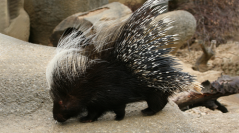

 Anthropozoologica
59 (10) - Pages 143-154
Anthropozoologica
59 (10) - Pages 143-154Only one unambiguous representation of a porcupine has been identified in ancient Egyptian art. Scholars agree that the image, which is found on a relief fragment from the Old Kingdom tomb of Pehenuka, depicts a North African crested porcupine (Hystrix cristata Linnaeus, 1758), a species that is no longer extant in Egypt. Other Egyptian images, which pre-date this example, have also been initially viewed as porcupines but then subsequently re-interpreted as mythical hybrid animals, based on what appears at first glance to be an unusual combination of their morphological characteristics. When both the principles of Egyptian graphic representation and the natural behaviour of porcupines are considered, however, greater support is found for their identification as crested porcupines. This finding highlights the importance of applying Egyptian graphic rules when analysing art from all periods, and suggests that North African crested porcupines are more common in early Egyptian art than has hitherto been appreciated.
Egyptian art, Hystrix cristata, composite images, hybrid animals.